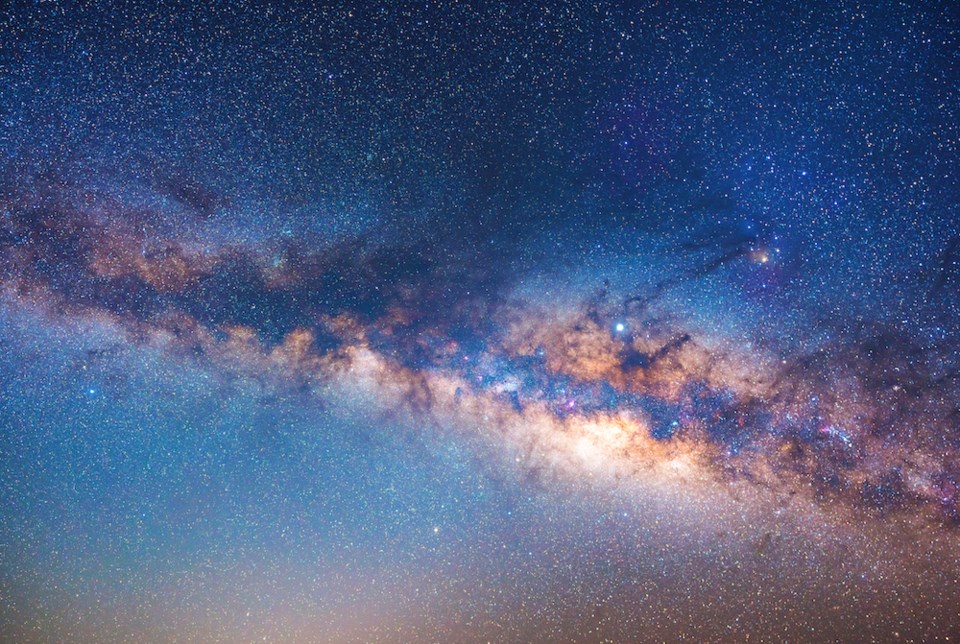If it’s August, it’s time for the Perseid meteor shower (weather permitting). This is one of the more populous showers; its Zenithal Hourly Rate (ZHR) is the estimated number of visible meteors at the peak, for the Perseids, about 90. Only the Quadrantids in January and the Geminids in December are higher at about 120 but the Perseids have the advantage of allowing us to spend hours looking up without the risk of frostbite. In addition, we’re much more likely to have clear skies in August.
This year the peak of the shower will be about 18:00 Aug. 12 with dark skies by about 20:30 or so. The peak is about two days long so you’ll likely see some one night before and after. The radiant for the Perseids – the point in the sky from which they seem to radiate – will be about 20 degrees above the horizon in the NNE. Do remember though, you will see these meteors anywhere in the sky; the best way to see them is find the spot with the widest view of the sky and away from bright lights, lie down and look up. No visual aids required. Unfortunately, this year’s peak also coincides with the rise of the moon, one day past full. The moonlight will wash out some of the fainter meteors but the Perseids have the reputation of being pretty bright and fast, as meteors go, so it still may be worthwhile. I have seen the Perseids show as many as two or three per minute but that’s uncommon. You never know what you’ll see.
Otherwise, early in the month before sunrise – about 04:00 – you can see Venus 5 degrees high in the ENE, Mars about 45 degrees high in the ESE, Jupiter 40 degrees high just west of due south and Saturn about 10 degrees up and 5 degrees west of a full moon on Aug. 12. Three days later, the moon is just below Jupiter, four days later on Aug. 19 it’s just above Mars and by Aug. 25, it will be just above Venus very low in the NE.
By about mid-August the now-waning moon will rise later each night; without the moon in the sky we’ll have the perfect opportunity to see the Milky Way at its best. When you look to the NNE at about 22:00 you can see the bright star Capella in Auriga about 10 degrees above the horizon. Above that is the constellation Perseus from where the meteors radiated; between Perseus and Cassiopeia ( the big “W”) above it you can see the Double Cluster – two open clusters of stars that are beautiful in binoculars. This direction is looking outwards along the disc of our galaxy to outer spiral arms and into intergalactic space. If you look about 15 degrees down and right of the upper “V” in Cassiopeia you can find a faint fuzzy patch with no discernible stars. That’s the Andromeda Galaxy, about two million light years away and the most distant object visible to unaided eyes.
After that, look straight up to see Deneb in the tail of Cygnus the Swan and look right (south) to see Vega in Lyra. Below them high in the SSW is Altair, the third star in the Summer Triangle. Below and to the right of the triangle is the center of our galaxy and the constellations of Sagittarius and Scorpio. The latter is one of the few constellations that actually does resemble its namesake, along with Cygnus and Leo. How Sagittarius is supposed to resemble a centaur holding a bow is a mystery to me but I’m almost certain alcohol was involved; to me it looks like a teapot. Interestingly, just to the right of the spout of the teapot is a small object known as Sagittarius A* – a black hole estimated to be about four million times the mass of our sun. There are a number of time-lapse videos on YouTube that show stars orbiting this monster at speeds up to about 3 per cent of the speed of light, That’s nearly 6,000 miles per second, by the way. The May 13 Astronomy Picture of the Day (APOD) shows an image of this black hole processed by the Event Horizon Telescope group. What astonishes me is that the object pictured is only ten light-minutes across; it would fit inside the orbit of Venus yet has four million times the mass of our sun. I’m also very happy it’s about 25,000 light years away.
There will be no SCAC meetings until the fall; accordingly I feel free to proselytize on behalf of Stellarium. This is an amazingly comprehensive software package that displays the sky for any time and place and can show what you can see naked eye or with binoculars or any other optical aids you can name. It is available for free at https://stellarium.org/ I would not be without it, especially since I’ve committed to writing monthly articles on Sechelt Skies. Any kids showing an interest in astronomy will eat it up.



